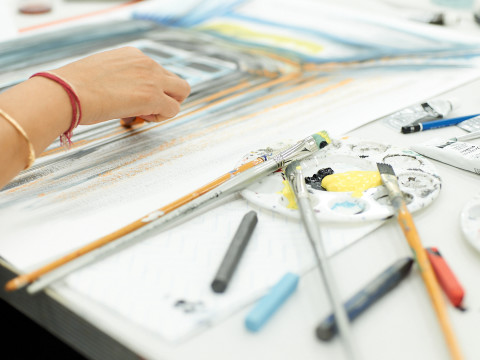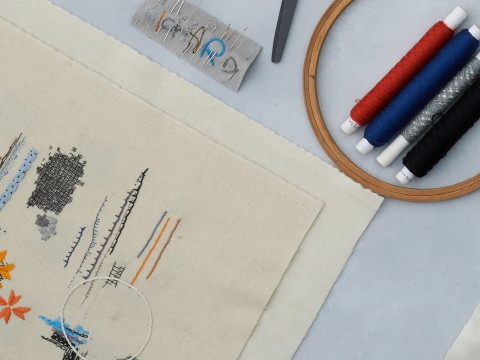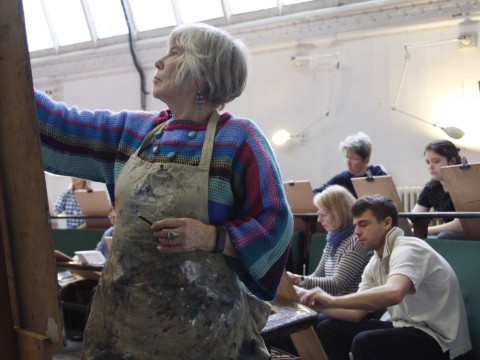
Wood engraving with Anne Desmet RA
Two-day masterclass and practical workshop
19 November 2016 10.30am - 5.30pm20 November 2016 10.30am - 5.30pm
Learning Studio, Burlington House, Royal Academy of Arts
£540. Includes all materials, a complimentary copy of Anne Desmet: An Italian Journey, published 2016, lunch and drinks reception.
Terms and conditions
Led by Anne Desmet, internationally renowned printmaker, collage artist and Royal Academician, this two-day practical workshop, appropriate for beginner and intermediate levels, will introduce the remarkable art and craft of traditional wood engraving printing and its specialist materials, tools, techniques and history in an intimate, small group setting.
Wood engraving is at once the simplest and yet one of the most exquisite forms of printmaking. From fine art through to editorial illustration and advertising to packaging, wood engraving finds more applications in the real world than most printmaking media.
In 15th and 16th-century Europe, woodcuts were a common technique in printmaking and printing, yet their use as an artistic medium began to decline in the 17th century. The beginnings of modern wood engraving techniques developed at the end of the 18th century with the works of Englishman Thomas Bewick. His work differed from earlier woodcuts in two key ways. First, rather than using woodcarving tools, Bewick used a copper engraver's burin (graver). With this, he could create thin delicate lines. Second, wood engraving traditionally uses the wood's end grain, while the older technique used the softer side grain. The resulting increased hardness and durability facilitated more detailed images.
Wood-engraved blocks could be used on conventional printing presses, which were going through rapid mechanical improvements during the first quarter of the 19th century. The blocks were made the same height as, and composited alongside, movable type in page layouts – so printers could produce thousands of copies of illustrated pages with almost no deterioration. The combination of this new wood engraving method and mechanised printing drove a rapid expansion of the medium in the 19th century. Its heyday lasted until the mid-20th century with exponents including Eric Gill, Eric Ravilious, Paul Nash and Gertrude Hermes RA. Though less used now, the technique is still prized in the early 21st century and is promoted, for example, by the Society of Wood Engravers in the UK.
Besides interpreting details of light and shade, from the 1820s onwards, engravers used the method to reproduce freehand line drawings. This was in many ways an unnatural application, since engravers had to cut away almost all the surface of the block to produce the printable lines of the artist's drawing. Nonetheless, it became the most common use of wood engraving. Examples include the cartoons of Punch magazine, the pictures in the Illustrated London News and Sir John Tenniel's illustrations to Lewis Carroll's works, the latter engraved by the firm of Dalziel Brothers.
Until 1860, artists working for engraving had to paint or draw directly on the surface of the block and the original artwork was actually destroyed by the engraver. In 1860, however, the engraver Thomas Bolton invented a process for transferring a photograph onto the block. At about the same time, French engravers developed a modified technique (partly a return to that of Bewick) in which cross-hatching (one set of parallel lines crossing another at an angle) was almost entirely eliminated. Instead, all tonal gradations were rendered by white lines of varying thickness and closeness, sometimes broken into dots for the darkest areas. This technique appears in engravings from Gustave Doré's drawings.
Towards the end of the 19th century, a combination of Bolton's 'photo on wood' process and the increased technical virtuosity initiated by the French school gave wood engraving a new application as a means of reproducing drawings in watercolour wash (as opposed to line drawings) and actual photographs. This is exemplified in illustrations in The Strand Magazine during the 1890s. With the new century, improvements in the half-tone process rendered this kind of reproductive engraving obsolete. In a less sophisticated form, it survived in adverts and trade catalogues until about 1930. With this change, wood engraving was left free to develop as a creative form in its own right.
£540. Includes all materials, a complimentary copy of Anne Desmet: An Italian Journey, published 2016, lunch and drinks reception.
Terms and conditions
About the course
This two-day practical workshop includes an introduction to historic and contemporary printmakers, from Edward Wadsworth to Henry Moore, and from Gertrude Hermes RA to Anne Desmet RA. Using the source material provided, or personal sketches or photographs to provide subject matter, participants will receive a comprehensive introduction to the tools and techniques of wood engraving, cutting and printing onto end-grain boxwood and lemonwood blocks to achieve diverse results from experimental, abstract cuts to detailed representational pieces.
At the end of the course, participants will have learned how to prepare, cut, ink and print wood engraving blocks (the techniques for which can also be applied to woodcutting and linocutting blocks) and will have created at least two small wood engraving prints to take home. Participants will have learned how to print blocks by hand, to a high degree of sophistication, without the use of a printing press, which is an excellent skill to enable participants to continue producing work after the course itself.
This course is for you if:
• You are a printmaker/artist with a desire to learn new techniques
• You are a collector of wood engraved prints and would like to learn how they are produced, and how to create your own.
• You are interested in the printmaking process in general and want to expand your horizons
• You would like to be introduced to an historic art form
Minimum age 18
The number of participants is strictly limited to 15 in order to enable detailed, individual feedback for each participant from the course tutor.
£540
Saturday 19 – Sunday 20 November 2016
Day 1: 10.30am – 5.30pm
Day 2: 10.30am – 5.30pm
Includes:
• An introduction to Royal Academician Anne Desmet, her artworks, role in the Royal Academy and international artworld
• All specialist, practical art materials
• Course learning materials and hand-outs developed by Anne Desmet RA
• Lunch and refreshments served on both days
• A complimentary copy of the publication Anne Desmet: An Italian Journey, published in 2016 by the Royal Academy
• A drinks reception in the recently opened Private Members Club, The Academician’s Room, on completion of the course.
• A certificate of participation upon course completion

About the Tutor
Anne Desmet RA
Anne Desmet RA studied at the Ruskin School of Drawing and Fine Art, University of Oxford (BA and MA) and London’s Central School of Art and Design. She was awarded a scholarship at the British School at Rome in 1989, is a Fellow of the Royal Society of Painter - Printmakers, a Member of the Society of Wood Engravers and was editor of Printmaking Today from 1998-2013. She is an experienced printmaking tutor in many British print workshops and art colleges, and is author of two practical printmaking handbooks: Handmade Prints and Primary Prints, both published by Bloomsbury. Anne also has an upcoming publication, titled Anne Desmet: An Italian Journey which is published by the Royal Academy. As an artist, Desmet uses the traditional printmaking techniques of wood engraving and lino cutting, for which she has won over 30 national and international awards and prizes, and her works are in many museum collections worldwide. As an extension of her printmaking practise, she draws on a variety of materials to create layered printed collages. Her work ranges from small scale, detailed examinations to sweeping, often fantastical panoramas viewed from a bird's eye perspective. Desmet uses collage and print to depict the built environment. She is engaged with the evolution of the urban landscape and its testimony to the aspirations and experiences of humanity. Her abiding inspiration lies in the architecture and landscape of Italy, as well as London's buildings and the biblical Babel Tower.

Our courses and classes programme
Our programme of short courses and classes offers the opportunity to explore a range of subjects, led by expert tutors and practising artists.
Related events
 Short courseFree
Short courseFreeThe Primary Art School
9 January - 12 June 2025
 Short course
Short courseBotanical art
11 March - 8 April 2025
 Short course
Short courseExploring ink: method and imagination
29 March - 30 March 2025
 Short course
Short courseDepicting the figure: Renaissance to Modernism
29 April - 27 May 2025
 Short course
Short courseRevolutionaries and Romantics: art and literature in France
17 May - 18 May 2025
 Short course
Short courseOil painting: techniques and discovery
17 May - 18 May 2025
 Short course
Short courseSketch with stitch
21 June - 22 June 2025
 Short course
Short courseConnoisseurship summer school: who painted what, when and how to tell
1 July - 5 July 2025
 Short course
Short courseLife drawing summer school
8 July - 12 July 2025
 Short course
Short courseDrawing with anatomy
15 July - 19 July 2025
 Short course
Short courseExpressive life drawing: observation and imagination
15 July - 19 July 2025
 Short course
Short courseLandscapes: van Gogh and his influence
2 September - 6 September 2025